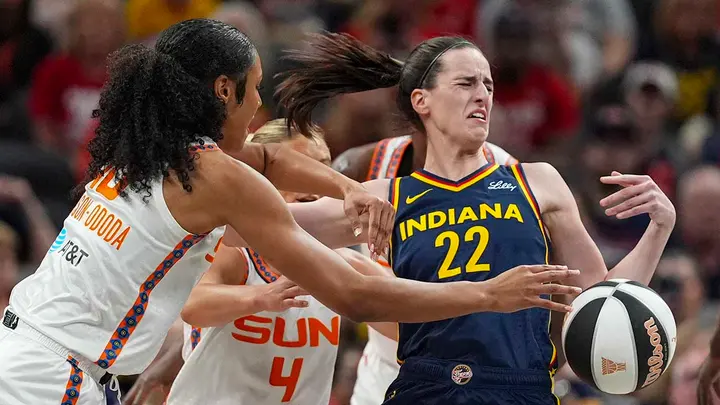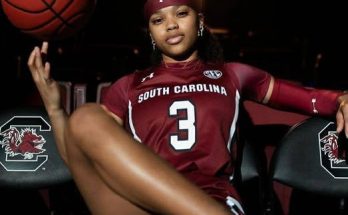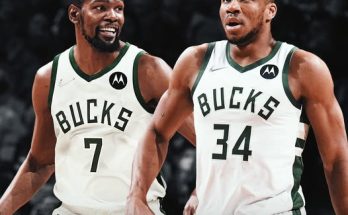Caitlin Clark, the Indiana Fever’s sensational rookie and one of the most talked-about athletes in the world, found herself at the center of yet another storm on the court. This time, it wasn’t for a record-breaking three-pointer or a dazzling no-look assist. Instead, it was a physical and emotional flashpoint that sparked outrage and renewed conversation about how the young star is being treated in the WNBA. During a highly charged matchup against the Connecticut Sun, Clark was poked in the eye and shoved to the ground in a tense on-court skirmish that quickly went viral. The moment left fans stunned, players divided, and the basketball world once again fixated on the rookie phenom.
The incident unfolded late in the second quarter as Clark attempted to cut across the court during an offensive possession. Jostling for position, she came into contact with a pair of Sun defenders. In what initially appeared to be a routine play, things escalated quickly. Replays showed Clark getting poked in the eye by one Sun player, staggering backward in visible discomfort. As she attempted to regain her balance, she was aggressively shoved to the floor by another Sun defender. The fall looked violent, and Clark stayed down momentarily, clearly shaken by the double blow.
Referees quickly blew the whistle, stopping the game as Fever players rushed to check on their teammate. Emotions were high on both benches. Fever coach Christie Sides was seen yelling toward the officials, demanding an explanation for the lack of an immediate flagrant foul call. Meanwhile, Sun players appeared defiant, gesturing that Clark had exaggerated the contact or initiated the physicality herself. What had started as a competitive play rapidly became a spectacle, drawing reactions across the league and online.
Clark, to her credit, composed herself and returned to the court after a brief examination from team trainers. Despite visible irritation in her eye and the emotional toll of the encounter, she played through the pain and finished the game with her trademark poise and production. Still, the game itself became secondary to the bigger conversation unfolding in real time: Is Caitlin Clark being targeted?
This wasn’t the first time Clark has found herself on the receiving end of physical play this season. As the face of a new generation of WNBA talent, the attention she draws is both a blessing and a burden. Crowds follow her everywhere. National media covers her every move. But with that spotlight has come a string of rough plays and controversial no-calls that many believe reflect a deeper issue. Is there resentment toward her sudden rise? Are veteran players sending a message to the rookie? Or is this just the physical nature of professional basketball meeting a new player still adjusting to the league’s physicality?
Former players and analysts were quick to weigh in. Some called the play “dirty” and “inexcusable,” arguing that had it been any other player, a flagrant foul would’ve been assessed without hesitation. Others insisted that Clark needs to adapt to the intensity of the pro level and that such physicality is part of the game. Still, the optics of the incident—Clark on the ground, clutching her face while Sun players loomed over her—fueled a wave of criticism and debate that extended far beyond basketball circles.
Social media platforms erupted. “Protect Caitlin Clark” trended on X, formerly Twitter, as fans demanded accountability. The WNBA released a statement later that evening acknowledging the incident was under review. While no immediate suspension or fine was handed down, league officials indicated they were examining the replay to determine if additional disciplinary measures were warranted.
Clark herself downplayed the moment in her postgame comments, showing her usual restraint and maturity. “Basketball is a physical game,” she said. “I’ve played through a lot before, and I’ll keep doing it. My focus is on helping this team get better every game.” Her words, calm and focused, only further highlighted her professionalism amid chaos.
However, Clark’s composure has not stopped the outcry. Her teammates and coaches expressed far more urgency. Aliyah Boston, the Fever’s rising star forward, called the treatment of Clark “unacceptable” and said the league needs to do more to ensure the safety of all players, regardless of status or experience. “We’ve got to protect our own,” Boston said. “She’s tough, but that doesn’t mean she should have to take that kind of abuse.”
The Fever organization echoed those sentiments, issuing a statement backing Clark and promising to work with the league to improve officiating and player safety. Fans, too, have begun calling for stronger enforcement of flagrant foul rules and more consistency from referees when it comes to protecting high-profile players.
Some have drawn parallels to the treatment other superstars have received early in their careers. LeBron James, Michael Jordan, Diana Taurasi—all faced aggressive defense and were tested physically by veterans. But others argue the treatment Clark is receiving feels different. Some say it’s more personal, driven by jealousy, skepticism, or resistance to the massive attention she brings to a league that has long struggled for mainstream relevance.
Indeed, Clark’s presence in the WNBA has been nothing short of transformative. Attendance at Fever games has skyrocketed. Road games draw sellout crowds. Television ratings are up dramatically. She’s helped create a buzz that many hoped for but few could have predicted. Yet with that spotlight comes scrutiny, and increasingly, the question is whether the league is ready to fully embrace and protect its newest star.
It’s a complicated dynamic. On one hand, Clark is praised for her toughness and resolve. She never shies away from contact, and she plays with a fearless edge. On the other hand, there’s growing concern that if incidents like the one against the Sun continue unchecked, they could lead to more serious injuries—or deter young stars from playing the game the way it’s meant to be played.
For now, Clark remains undeterred. She continues to lead by example, logging heavy minutes and putting up impressive numbers despite the physical toll. Her competitiveness is unshakable, her leadership clear. But the league finds itself at a crossroads. Will it take steps to protect its most marketable player? Or will it allow the physical punishment to continue under the guise of “letting them play”?
The incident against the Sun wasn’t just a moment of contact—it was a collision of narratives. Old school versus new. Grit versus glamour. Respect versus resentment. And Caitlin Clark, whether she likes it or not, is at the center of it all.
What happens next could shape not just her career, but the future of the WNBA. Will the league lean into its growth and protect its biggest investment? Or will it allow the game’s unwritten codes to dictate the treatment of its brightest stars? One thing is certain: Caitlin Clark will keep showing up, keep competing, and keep proving that she belongs. But for the good of the game, others need to start showing up for her, to.



